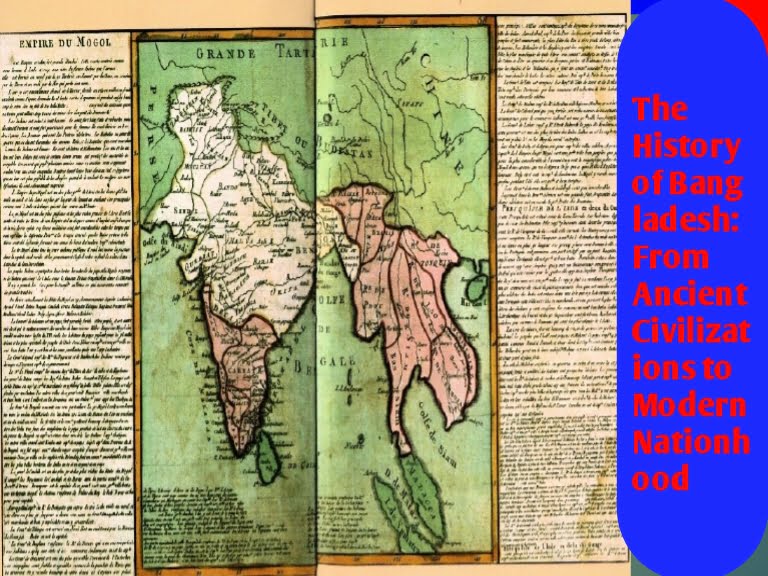The History of Bangladesh: From Ancient Civilizations to Modern Nationhood
The History of Bangladesh
Bangladesh, a country rich in culture and history, is located in South Asia, bordered by India, Myanmar, and the Bay of Bengal. Its history is marked by a series of significant events, from ancient civilizations to colonial rule, and from a struggle for independence to becoming a modern nation. This article provides an in-depth look at the history of Bangladesh, tracing its journey through different eras.
Ancient Period:
- Early Civilizations:
- The region that is now Bangladesh was part of the ancient kingdom of Vanga, one of the earliest known settlements in the area. Evidence suggests that urban civilization in this region dates back to 3000 BCE.
- Maurya and Gupta Empires:
- Around 4th to 2nd centuries BCE, the Maurya Empire, founded by Chandragupta Maurya, included Bengal. Later, the Gupta Empire, known for its advancements in arts and sciences, ruled the region from the 4th to 6th centuries CE.
- Pala Dynasty:
- From the 8th to the 12th centuries, the Pala Dynasty, a Buddhist kingdom, dominated Bengal. The Pala period is considered a golden age for Buddhism in the region, marked by significant cultural and educational achievements.
Medieval Period:
Reading more…. Recruitment for 2424 Assistant Professor Posts: Applications Begin on 7th August – Complete Details Inside
- Islamic Influence:
- The 13th century saw the arrival of Islam in Bengal with the conquest by Turkish general Bakhtiyar Khilji. The region gradually became a part of the Bengal Sultanate, which lasted until the 16th century.
- Mughal Empire:
- In the 16th century, Bengal was integrated into the Mughal Empire. Dhaka emerged as an important administrative and commercial center under Mughal rule. The period witnessed economic prosperity and the flourishing of arts and culture.
Colonial Period:
- British East India Company:
- The 18th century marked the beginning of British colonial rule after the Battle of Plassey in 1757, where the British East India Company defeated the Nawab of Bengal. This led to the establishment of British dominance over Bengal.
- Colonial Administration:
- Bengal became a significant part of British India. The colonial period was characterized by economic exploitation, famines, and the growth of nationalist movements. The partition of Bengal in 1905 and its subsequent reunification in 1911 were significant events during this period.
Partition and Pakistan Era:
- Partition of India:
- In 1947, British India was partitioned into India and Pakistan. Bengal was divided into West Bengal (India) and East Bengal (Pakistan). East Bengal was later renamed East Pakistan.
- Language Movement:
- The Language Movement in the early 1950s was a pivotal event, where Bengalis protested against the imposition of Urdu as the sole national language. The movement culminated on February 21, 1952, with the martyrdom of several students, a day now commemorated as International Mother Language Day.
- Struggle for Autonomy:
- Throughout the 1950s and 1960s, there was growing dissatisfaction in East Pakistan over economic disparity and political marginalization by the West Pakistani leadership. The demand for autonomy gained momentum under leaders like Sheikh Mujibur Rahman.
Independence and Modern Era:
- War of Independence:
- The Bangladesh Liberation War began on March 26, 1971, following widespread civil disobedience and brutal military crackdowns by Pakistani forces. With the support of India, East Pakistan declared independence and became Bangladesh after a nine-month-long war.
- Post-Independence Challenges:
- Bangladesh faced numerous challenges in the aftermath of independence, including political instability, economic difficulties, and rebuilding from war devastation. Sheikh Mujibur Rahman became the country’s first Prime Minister.
- Political Turmoil:
- The assassination of Sheikh Mujibur Rahman in 1975 led to years of political turmoil, military coups, and the establishment of military rule. The country gradually returned to civilian rule in the 1990s, with the restoration of democratic institutions.
Economic and Social Development:
- Economic Growth:
- Since the 1990s, Bangladesh has made significant strides in economic development, transitioning from a low-income to a lower-middle-income country. The country has achieved remarkable progress in sectors such as textiles, agriculture, and information technology.
- Social Progress:
- Bangladesh has also made notable improvements in social indicators, including education, healthcare, and women’s empowerment. The country has seen substantial reductions in poverty and improvements in life expectancy and literacy rates.
Conclusion: The history of Bangladesh is a testament to the resilience and determination of its people. From ancient civilizations to colonial struggles, and from the fight for independence to modern-day achievements, Bangladesh has carved out a unique identity on the global stage. As the country continues to develop, its rich history remains a source of pride and inspiration for its future generations.
How did you like the information given in our article today, please tell us in the comment section and for more such posts, follow our page The News House, thank you


